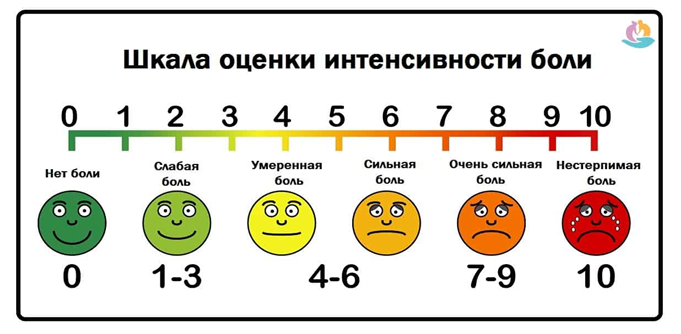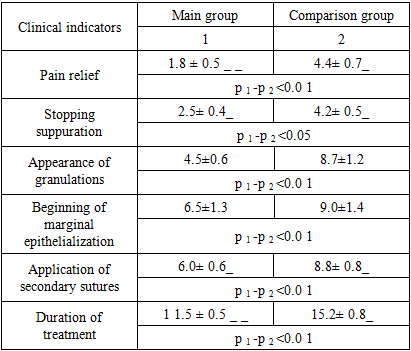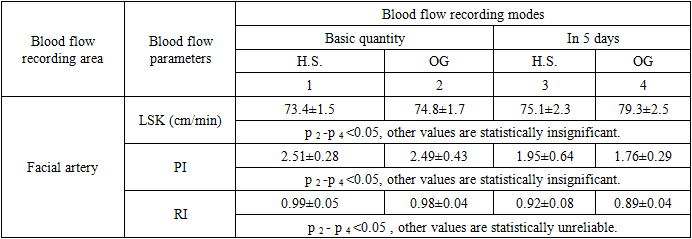-
Paper Information
- Previous Paper
- Paper Submission
-
Journal Information
- About This Journal
- Editorial Board
- Current Issue
- Archive
- Author Guidelines
- Contact Us
American Journal of Medicine and Medical Sciences
p-ISSN: 2165-901X e-ISSN: 2165-9036
2024; 4(2): 365-368
doi:10.5923/j.ajmms.20241402.44
Received: Jan. 21, 2024; Accepted: Feb. 5, 2024; Published: Feb. 12, 2024

Effectiveness of Sorption-Applection Therapy in the Clinic of Maxillofacial Surgery for Purulent Diseases
Juraev B. N.1, Khalmatova M. A.1, Ksembaev S. S.2
1Tashkent State Dental Institute, Tashkent, Republic of Uzbekistan
2Kazan State Medical University, Kazan, Russian Federation
Copyright © 2024 The Author(s). Published by Scientific & Academic Publishing.
This work is licensed under the Creative Commons Attribution International License (CC BY).
http://creativecommons.org/licenses/by/4.0/

Relevance. Local treatment of purulent wounds continues to be a relevant and challenging task in modern surgery. Today, there are such a large number of proposed means of influencing a purulent wound that we can state both their lack of effectiveness and the need to find new ways to improve them [1-5]. The goal is to conduct a comparative assessment of the clinical effectiveness of the cotton cellulose sorbent “Celoform-Neo”. We examined 101 patients aged 20-49 years (men - 53, women - 48), admitted for inpatient treatment with an established diagnosis: Acute odontogenic osteomyelitis of the lower jaw, complicated by phlegmon of one cellular space (submandibular, submental, masticatory, pterygo-submandibular phlegmon) and divided into 2 groups: the main group (MG) of 55 people and the comparison group (CG) - 46 people. The study groups were statistically significantly comparable in age (p=0.90). Conclusion. A study conducted to evaluate the clinical effectiveness of the cotton cellulose sorbent “Celoform-neo” revealed the advantages of sorption-application therapy in all comparable parameters, such as the dynamics of clinical indicators, reduction of pain, improvement of regional blood circulation in the area of purulent inflammation.
Keywords: Acute odontogenic osteomyelitis, Purulent-inflammatory process, Celoform-Neo, Sorbents – cellulose and odontogenic phlegmon
Cite this paper: Juraev B. N., Khalmatova M. A., Ksembaev S. S., Effectiveness of Sorption-Applection Therapy in the Clinic of Maxillofacial Surgery for Purulent Diseases, American Journal of Medicine and Medical Sciences, Vol. 4 No. 2, 2024, pp. 365-368. doi: 10.5923/j.ajmms.20241402.44.
1. Topicality
- Local treatment of purulent wounds continues to be a relevant and challenging task in modern surgery. Today, there are such a large number of proposed means of influencing a purulent wound that we can state both their ineffectiveness and the need to find new ways to improve them [1-5].At the present stage, a variety of methods and methods are used for the treatment of wounds in the maxillofacial area. The basis of scientific approaches to the problem of local treatment of wounds is the concept of choosing the optimal drug in accordance with the stages of the wound process [6,7].Significant progress in the treatment of wounds is associated with the introduction into clinical practice of a group of medical sorbents that have an active cleansing effect on the wound. Sorbents – cellulose and its derivatives – are widely used in medicine.From this point of view, based on the cotton-cellulose sorbent “Celoform”, which had previously proven its clinical effectiveness [8], a new cotton-like sorbent “Celoform-Neo” was developed.Objective is to conduct a comparative assessment of the clinical effectiveness of the cotton -cellulose sorbent “Celoform-Neo”.
2. Materials and Methods
- We examined 101 patients aged 20-49 years (men - 53, women - 48), admitted for inpatient treatment with a diagnosis: Acute odontogenic osteomyelitis of the lower jaw, complicated by phlegmon of one cellular space (submandibular, chin, chewing, pterygo-submandibular phlegmon) and divided into 2 groups: the main group (MG) - 55 people and the comparison group (CG) - 46 people. The study groups were statistically significantly comparable in age (p=0.90).During the clinical examination, all patients had pain in the area of the purulent-inflammatory process, limited mouth opening due to increased pain, facial asymmetry due to the presence of severe inflammatory edema of the soft tissues of the affected side, which intensified after the operation. (opening of phlegmon).The examination included general clinical (history, assessment of general and local status) and special (laboratory, instrumental) research methods. Laboratory indicators: leukocytosis, increase in ESR (up to 20 - 30 mm/hour and higher), shift of bands to the left, phenomena of micro- and anisocytosis.OS patients complained of local intense pain, dysfunction of the affected area, increased body temperature, swelling or swelling of the soft tissues of the maxillofacial area.When carrying out complex treatment, we were guided by the well-known principles of purulent surgery: opening a purulent-inflammatory focus by layer-by-layer dissection of the tissue above it, washing and adequate drainage of the resulting purulent wound with drainage tubes. or rubber graduates. Patients of the main group (MG), in contrast to patients of the comparison group (CG), after opening the phlegmon, the sorbent “Celoform-neo” was added to the surgical wound (Figure 1).
 | Figure 1. View of the surgical wound after opening the phlegmon chin area in a patient of the main group |
 | Figure 2. Visual analogue scale for assessing pain level |
3. Results
- During the treatment process, the dynamics of clinical indicators of patients with OS were recorded, which are reflected in the comparative aspect in Table 1.
|
|
|
4. Conclusions
- A study conducted to evaluate the clinical effectiveness of the cotton-cellulose sorbent “Celoform-neo” revealed the advantages of sorption-application therapy in all comparable parameters, such as the dynamics of clinical indicators, reduction of pain, improvement of regional blood circulation to the site of purulent inflammation.
 Abstract
Abstract Reference
Reference Full-Text PDF
Full-Text PDF Full-text HTML
Full-text HTML

